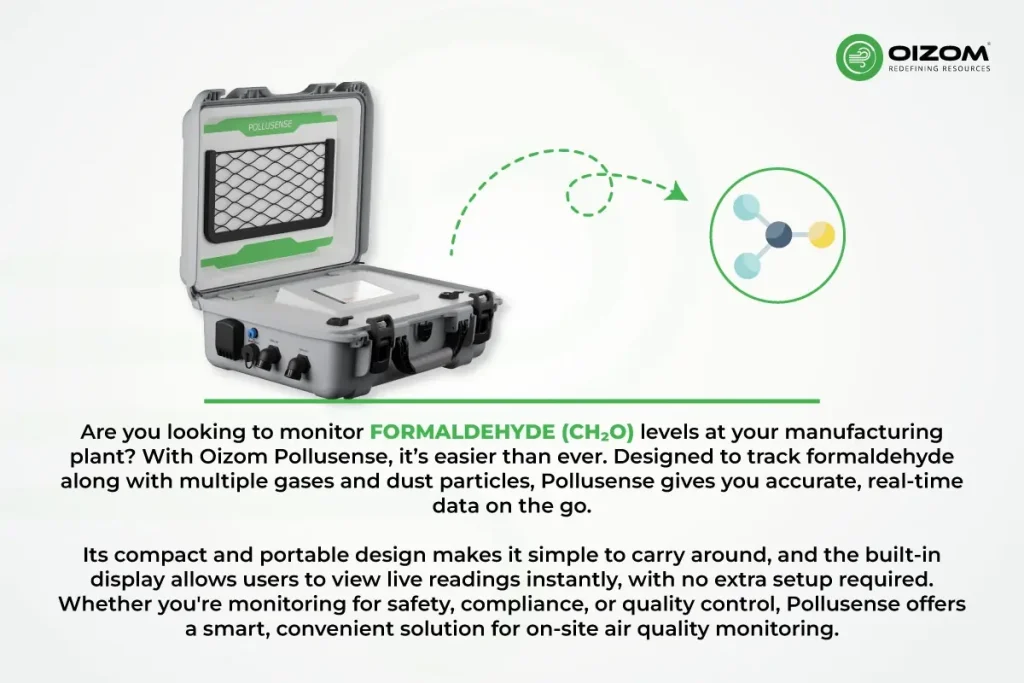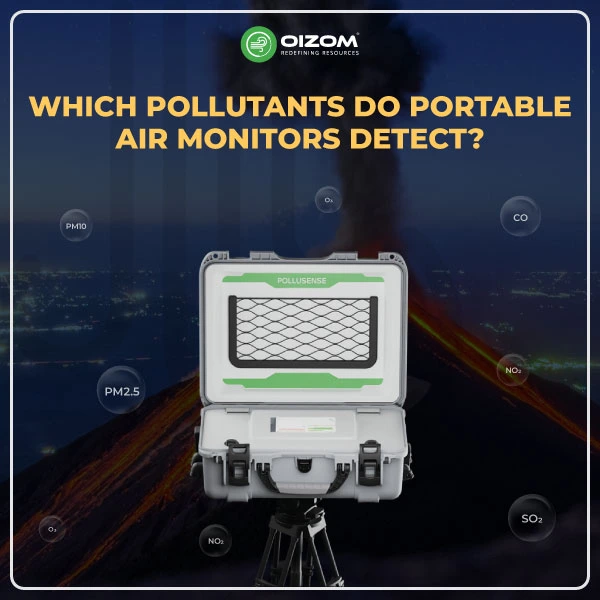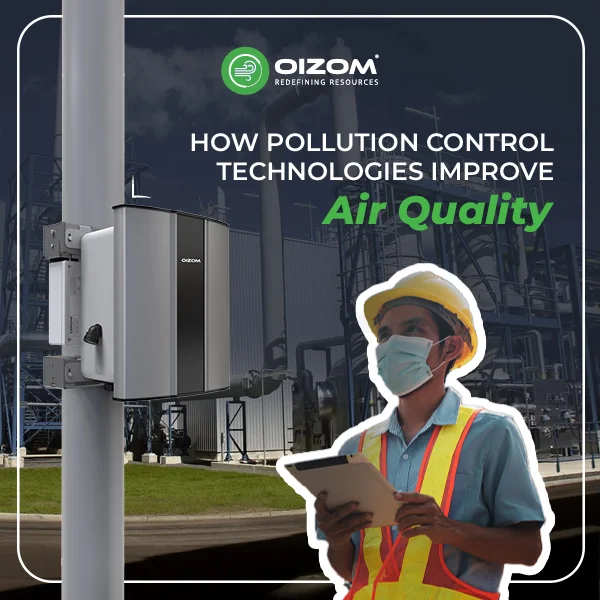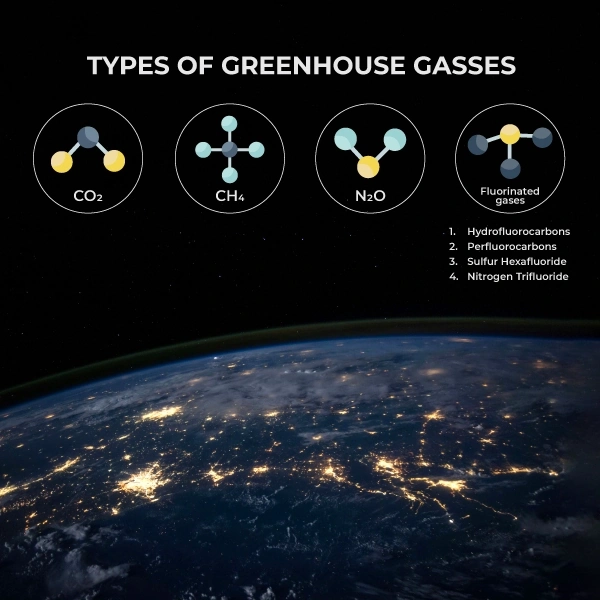Summary of Blog
Portable air quality monitors have made it easier than ever to check pollution levels in real-time. These small, easy-to-carry devices can detect many harmful pollutants like dust (PM1, PM2.5, PM10), gases (CO, NO₂, O₃, SO₂), and chemicals like VOCs, formaldehyde, and even radon. Some advanced models can also track heavy metals and BTEX compounds found in industrial areas.
Using smart sensors and built-in corrections for temperature and humidity, they give accurate and reliable data on the spot. Whether you’re working in industry, doing research, or checking for safety, these monitors help you get the information you need quickly.
With new features like cloud connectivity and AI-powered insights, portable air monitors are becoming smarter and more powerful, making them must-have tools for tackling today’s air quality problems.
Which Pollutants Do Portable Air Monitors Detect?
Portable air quality monitors have transformed how professionals assess environmental conditions, bringing lab-level insights to the field in real-time. If you’re in the air quality domain, you’re already aware of the need to identify specific pollutants accurately. But with advancements in sensing technology, these compact devices now offer more than just mobility; they deliver precision.
Modern portable monitors can detect a wide array of pollutants, including particulate matter (PM1, PM2.5, PM10, and PM100), volatile organic compounds (VOCs), nitrogen dioxide (NO₂), ozone (O₃), carbon monoxide (CO), and sulfur dioxide (SO₂). Many models also integrate environmental sensors for temperature, humidity, and noise, providing valuable context for air quality data.
Thanks to electrochemical, NDIR, and optical sensors and innovations in semiconductor miniaturization, detection capabilities now rival those of stationary reference-grade systems, especially for targeted applications. With detection thresholds in parts per billion (ppb) and response times under 30 seconds, these monitors are built for real-time, high-accuracy readings.
Additionally, smart compensation algorithms now account for variables like temperature and humidity, reducing cross-sensitivity and improving data reliability. These improvements have made portable monitors indispensable for field researchers, EHS managers, and environmental auditors. In this blog, we’ll explore which pollutants are detectable using today’s portable air quality monitors, how different sensing technologies work, and what limitations to consider when analyzing real-world data.
Common Pollutants Detected by Portable Air Quality Monitors
When using portable air quality monitors, it’s important to understand which pollutants they can detect, especially if you’re relying on them for field studies, compliance checks, or environmental assessments. Thanks to advancements in sensor technology, these devices now measure a wide range of harmful pollutants with impressive accuracy.
Most portable monitors can track particulate matter like PM1, PM2.5, and PM10 using laser-scattering sensors. These help assess the level of dust and fine particles that pose serious health risks when inhaled.
For gaseous pollutants, such as nitrogen dioxide (NO₂), sulfur dioxide (SO₂), carbon monoxide (CO), and ozone (O₃), portable monitors often use electrochemical sensors. These are known for their sensitivity and are widely trusted in both industrial and urban monitoring.
To measure volatile organic compounds (VOCs) like benzene or formaldehyde, PID (photoionization detectors) or MOS sensors are typically used. Some devices also include NDIR sensors for tracking carbon dioxide (CO₂), which is useful in indoor air quality and ventilation studies.
With smart compensation for temperature and humidity, today’s portable monitors offer reliable data in real-world conditions. In the following sections, we’ll dive deeper into each pollutant type and how these compact devices accurately detect them.
Particulate Matter (PM)
So, what characteristics do particle matter have? According to the USEPA, particulate matter (PM) is a mixture of solid particles and liquid droplets in the air. Some particles, such as dust and dirt, are visible to the human eye, while others are so minute that they can only be seen with a microscope. They are collectively responsible for all the particle pollution we see daily.
The consequences of particulate matter on human health vary with particle diameter, so monitoring different particle sizes, such as PM2.5 and PM10, is crucial. There is a famous saying that “You cannot manage what you cannot measure.”. Whether you’re managing construction sites, mines, or ports, using a Portable Particulate Monitor ensures accurate air quality tracking, from the tiniest PM1 particles to the largest PM100.
Did you know this? Only 9% of countries have ambient air quality standards for particulate matter pollution (PM2.5) that meet World Health Organization (WHO) guidelines.
Carbon Monoxide (CO)
Carbon monoxide (CO) is an odourless, colorless, and tasteless gas that cannot be detected by the human senses. Carbon monoxide poisoning is sometimes referred to as a “silent killer” due to its indistinguishable. Carbon monoxide can be hazardous if inhaled. As it enters the bloodstream, it can hinder your body from taking oxygen properly, causing tissue damage and, eventually, death.
According to the CDC, more than 20,000 patients visit the emergency room each year as a result of carbon monoxide poisoning. While no one is immune to the effects of this deadly gas, newborns, the elderly, and persons with heart or respiratory issues are more vulnerable to CO poisoning.
CO is naturally present in the atmosphere at very low concentrations of about 0.2 ppm, which is not harmful to humans independently. CO is released naturally from volcanic eruptions, forest fires, etc. However, human activities are the biggest source of CO emissions, among which the largest proportion are emitted by the exhaust of internal combustion engines of motor vehicles running on petrol and diesel. It remains in the atmosphere for about two months and eventually reacts with oxygen to form carbon dioxide.

Nitrogen Dioxide (NO2)
Nitrogen dioxide, or NO2, is a gaseous air pollutant made up of nitrogen and oxygen. It is part of a group of gases known as nitrogen oxides, or NOx. Nitrogen dioxide is produced when fossil fuels like coal, oil, methane gas (natural gas), or diesel are burned at high temperatures. In outdoor air, NO2 and other nitrogen oxides contribute to particle pollution and the chemical processes that produce ozone.
It is a respiratory irritant that can exacerbate the symptoms of an existing respiratory infection. Nitrogen dioxide increases the susceptibility of asthmatics to lung infections and asthma triggers such as pollen and exercise.
Of the nitrogen compounds released during combustion, 10% is NO2, while 90% is NO. Once released in the atmosphere, Nitrogen dioxide can combine with other atmospheric chemicals to generate acid rain, harming ecosystems and human-built monuments, structures, and cultural sites. Nitrogen oxides, including NO₂, produce nitrate particles that cause haze and reduced visibility. Elevated NO₂ levels can cause environmental damage, including nutrient pollution in coastal water.
Ozone (O3)
Ozone (O3) is a highly reactive gas composed of three oxygen atoms. It is both a natural and a man-made product that occurs in the Earth’s upper atmosphere (the stratosphere) and lower atmosphere (the troposphere). Depending on where it is in the atmosphere, ozone affects life on Earth in either good or bad ways.
Stratospheric ozone is formed naturally through the interaction of solar ultraviolet (UV) radiation with molecular oxygen (O2). The “ozone layer,” approximately 6 through 30 miles above the Earth’s surface, reduces the amount of harmful UV radiation reaching the Earth’s surface.
Volatile Organic Compounds (VOCs)
Total Volatile Organic Compounds (TVOCs) are a group of carbon-based chemicals found in both indoor and outdoor air. While the name may sound complex, their presence affects the air we breathe every day. These compounds easily become vapors or gases due to their high vapor pressure. They can come from common sources like cleaning products, paints, furniture, and even cooking.
TVOCs include a wide variety of chemicals, some are harmless, while others can be toxic. Many are colorless and odourless, making them hard to detect without proper monitoring. Scientists estimate there could be over 10,000 different VOCs in our environment. Monitoring TVOCs is a practical way to check for potentially harmful exposure, especially in indoor spaces where ventilation is limited.
TVOCs play a key role in evaluating indoor air quality and understanding potential health risks. By keeping track of them, we can create healthier living and working environments.
Did you know this? America Cancer Society has classified chemicals like Benzene and Formaldehyde, which can be found in paint, glue, furniture wax, detergents, and thinners, as human carcinogens.
Sulfur Dioxide (SO2)
Sulfur oxides are a group of gases made from sulfur and oxygen, mainly sulfur dioxide (SO₂) and sulfur trioxide (SO₃). Of these, SO₂ is the most common and harmful when it comes to air pollution. It’s mostly released from burning fossil fuels like coal and oil, as well as from industrial activities. Though often invisible, SO₂ can cause serious health problems, especially for the lungs, and is a major contributor to acid rain and smog.
SO₂ is one of the six “criteria pollutants” regulated under the Clean Air Act in the U.S., which sets air quality limits to protect human health and the environment. Monitoring sulfur dioxide levels is important to track and reduce pollution, especially from sources that form fine particles and lead to poor air quality.
Sulfur dioxide (SO2) is a colorless gas with a strong, sharp odour that can cause discomfort, often making it hard to breathe. It is mainly released into the air from burning sulfur-rich fuels like coal, oil, and diesel, especially in power plants and industrial operations like copper smelting. Natural sources, such as volcanic eruptions, also emit SO2.
Air Pollutants Overview
| Pollutant | Common Sources | Health Impact | Sensor Type |
|---|---|---|---|
| PM2.5, PM10 | Dust, vehicle exhaust | Respiratory & Cardiovascular | Laser scattering sensor |
| CO | Vehicles, combustion | Oxygen deprivation, fatality | Electrochemical sensor |
| VOCs | Paints, cleaners | Irritation, carcinogenic | PID/MOS sensor |
| Formaldehyde | Furniture, adhesives | Respiratory issues, cancer | PID sensor |
Advanced Pollutants Detected by High-End Monitors
High-end air quality monitors are designed to detect more than just the common pollutants. These advanced systems are built for specialized applications, such as industrial safety, environmental research, and regulatory compliance. Where detecting complex or less-visible pollutants is critical.
Unlike basic monitors, high-end devices can measure hazardous air pollutants (HAPs) like formaldehyde, hydrogen sulfide (H₂S), benzene, toluene, Ethylbenzene, and xylene (BTEX). These are often found in industrial emissions and can be harmful even at very low levels. To detect them accurately, these monitors use advanced sensors such as photoionization detectors (PIDs), flame ionization detectors (FIDs), and metal oxide or electrochemical sensors.
Looking to monitor BTEX levels but not sure how to get started? You’re in the right place! Oizom has recently added a specialized sensor to its portfolio that is designed specifically to measure these hazardous air pollutants. Whether it’s benzene, toluene, ethylbenzene, or xylene, we’ve got you covered.
Want to learn more about how it works and how it can fit into your monitoring setup? Get in touch with our experts today; we’re happy to help!
They also detect gases like ammonia (NH₃), chlorine (Cl₂), and phosphine (PH₃), which are common in chemical plants, fertilizer factories, and wastewater treatment facilities. Some high-end systems even include optical methods like FTIR (Fourier-transform infrared) or UV-based sensors to improve detection accuracy and reduce interference. In high-risk environments, like refineries or landfills, monitoring these advanced pollutants is essential for safety, health, and environmental compliance.
Formaldehyde
Formaldehyde (CH₂O), also known as methanal, is a colorless gas with a strong, sharp smell, often compared to pickles. It’s found both indoors and outdoors and is part of a group called volatile organic compounds (VOCs), which quickly turn into gas at room temperature.
Formaldehyde is widely used in manufacturing building materials, furniture, and household products. Indoors, it can be released from pressed-wood furniture, paints, glues, and cleaning products, which can lower indoor air quality in homes, schools, and offices.
It doesn’t just come from man-made sources; natural processes, fuel burning, and chemical reactions in the air also release formaldehyde into the environment. Whether you’re in a city or rural area, exposure is possible. Even at low levels, it can cause eye, nose, and throat irritation, and long-term exposure may lead to respiratory issues and cancer.
To help detect and prevent harmful exposure, formaldehyde monitors are used in both industrial and indoor settings. These devices provide real-time alerts to maintain safer air quality. Formaldehyde is the simplest aldehyde, made of carbon, hydrogen, and oxygen, with the formula CH₂O. It’s often stored as formalin to prevent it from turning into a solid (paraformaldehyde).
Are you looking to monitor formaldehyde (CH₂O) levels at your manufacturing plant? With Oizom Pollusense, it’s easier than ever. Designed to track formaldehyde along with multiple gases and dust particles, Pollusense gives you accurate, real-time data on the go.
Its compact and portable design makes it simple to carry around, and the built-in display allows users to view live readings instantly, with no extra setup required. Whether you’re monitoring for safety, compliance, or quality control, Pollusense offers a smart, convenient solution for on-site air quality monitoring.
Did you know? Recognized globally as hazardous, formaldehyde was classified as a Group 1 human carcinogen by the World Health Organization (WHO) and as a 1B carcinogen and mutagen by the European Commission.

Radon
We’re surrounded by radiation in our daily lives, from kitchen microwaves to car radios, but most of it is completely harmless. However, one natural source of radiation that can pose serious health risks is radon.
Radon is a radioactive gas that has no color, smell, or taste. It’s released naturally from rocks and soil as uranium, thorium, or radium break down. Outdoors, radon gets diluted in the open air and usually doesn’t cause any harm.
The real concern is indoor radon. It can seep into buildings through cracks in floors or walls and accumulate to dangerous levels. Studies have shown that even moderate indoor radon exposure, like what’s commonly found in homes and workplaces, can increase the risk of lung cancer, especially with long-term exposure.
Radon can also come from building materials, soil, or water used in construction. That’s why organizations like the International Atomic Energy Agency (IAEA) have set safety standards for acceptable radon levels in homes and workplaces to protect people’s health. Radon, which exists in various isotopes, is primarily classified into radon-222 and radon-220. During its radioactive decay, radon-222 emits alpha particles, beta particles, and gamma radiation.
Monitoring radon levels, especially enclosed spaces, is key to ensuring a safe indoor environment. Were you aware of this? Radon is the second leading cause of lung cancer after smoking. When inhaled, radon and its decay products can irradiate the cells lining the respiratory tract, potentially leading to DNA damage and the development of cancer.
Heavy Metals (Lead, Mercury)
Heavy metals like lead (Pb) and mercury (Hg) are critical pollutants in air quality monitoring, especially in industrial zones, waste incineration sites, and areas near smelting operations. Though not typically present in high concentrations in ambient air, even trace levels of these metals can pose serious health and environmental risks due to their toxicity and ability to bioaccumulate.
Lead is often released from battery manufacturing, metal processing, and legacy sources like leaded gasoline or paint. Mercury, on the other hand, is primarily emitted from coal combustion, cement production, and waste incineration. Once airborne, both can attach to fine particulate matter (PM2.5), allowing them to travel long distances and enter the respiratory system.
Advanced air quality monitors use filter-based sampling combined with ICP-MS or AAS analysis to measure heavy metals accurately. Some high-end continuous ambient air monitors also integrate XRF (X-ray fluorescence) technology for real-time detection.
Given their classification as hazardous air pollutants (HAPs) by the EPA, monitoring lead and mercury is crucial for ensuring regulatory compliance, protecting public health, and supporting environmental justice in vulnerable communities. Understanding their behavior in the atmosphere helps professionals assess exposure risks and design effective mitigation strategies.
Field Challenges and Sensor Reliability: What Experts Should Know
While portable air quality monitors have become remarkably sophisticated, domain professionals know that their real-world deployment comes with challenges. To extract actionable insights, it’s essential to understand calibration, sensor drift, environmental impact, and comparability with reference-grade instruments.
Sensor Calibration and Drift
Electrochemical and optical sensors, while compact and responsive, are subject to sensor drift, a gradual deviation from true readings due to aging, environmental exposure, or accumulation of particulates and gases.
Most high-end devices now include:
- Factory calibration using traceable gas standards
- Auto-calibration routines with internal references
- On-site manual calibration options using zero/span gas kits
Professionals should ensure routine calibration schedules, especially in industrial or high-pollution environments where sensor degradation may accelerate.
Co-location and Performance Benchmarking
Many experts co-locate portable monitors with reference-grade instruments (like BAM, FEM analyzers) for performance validation. Studies often reveal:
- 80–90% correlation for PM2.5 when environmental factors are controlled
- Electrochemical sensors for NO₂ or CO may show excellent short-term response but require correction algorithms for temperature and humidity drift
Benchmarking ensures data confidence, especially when used in regulatory-adjacent applications.
Known Limitations in Portable Deployments
Despite advancements, portable monitors are not immune to challenges, such as:
- Cross-sensitivity: Some gases (e.g., O₃ and NO₂) can interfere with each other’s readings in electrochemical cells
- High humidity errors: Optical particle counters may overcount due to water vapor unless compensated with humidity correction
- Power constraints in remote areas, unless solar or long-battery variants are used
Understanding these can help in designing more resilient deployment strategies.
Conclusion
In today’s fast-paced world, portable air quality monitors have become essential tools for professionals who need real-time, reliable data anytime, anywhere. From particulate matter (PM1, PM2.5, PM10) to gaseous pollutants like NO₂, CO, O₃, SO₂, VOCs, and even advanced parameters like BTEX or formaldehyde, these compact devices offer impressive sensing capabilities powered by advanced electrochemical, optical, PID, and NDIR sensors.
Their accuracy, speed, and ease of deployment make them ideal for everything from industrial safety checks to urban air quality assessments. But as sensor technology continues to evolve, we can expect even greater sensitivity, multi-pollutant tracking, and AI-based data analytics in future models.
Looking ahead, portable monitors are becoming even more smarter, offering predictive insights, cloud integration, and real-time alerts tailored for dynamic environments. For air quality professionals, staying updated with these advancements will be key to making informed decisions and driving impactful change in environmental monitoring.
Whether you’re measuring for health, compliance, or research, portable monitors offer a powerful, flexible solution for tackling today’s air quality challenges, and tomorrow’s.






